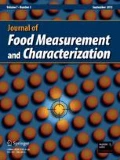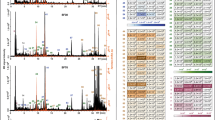Abstract
Musa acuminata (Musaceae) is a wild species native to South East Asia. In addition to its potential as a food crop, different non-food morphological parts of the plant have been investigated for various pharmacological activities, including anticholinesterase and antioxidant activity. This study aimed to characterize Musa leaf extracts based on their phenolic composition and their agro-morphological traits. A metabolomic approach was applied to discover biomarkers that can be used to separate eight accessions of the species originating from five different countries. Statistical analysis was employed for data analysis. The antioxidant activity and total phenolic content was measured by Ferric Reducing Antioxidant Power (FRAP) assay and Folin–Ciocalteu colorimetric method, respectively. Over 500 metabolites were observed. Thirty-one of them were important for defining variations among the accessions. The identities of some of these markers were confirmed based on their MS2 fragmentation. These include Quercetin O-rhamnoside-O hexoside (m/z 609), Kaempferol-3-O-rutinoside (m/z 593), Quercetin O hexoside (m/z 463), Hexadecanoic acid (m/z 255), Rhamnoside-O-rutinoside (m/z 623). Country of origin and methods of extraction did not play any significant role in the separation, although extraction of accessions by Soxhlet gave better yield (20.0–60.0%) than by sonication (18.4–23.0%). Accession TMp 24 from Nigeria gave the highest yield in both methods of extraction. The sonicated accession TMb 8 exhibited highest antioxidant activity having FRAP values of 49.14 mg GAE/g and 125.10 mg TROLOX/g. The next accession in FRAP activity was the sonicated leaf extract of TMb 116 with 31.69 mg GAE/g and 121.57 mg TROLOX/g. The PCA analysis allowed the separation of the accessions into two groups. The metabolomics approach was found to be informative as a screening tool of the Musa accessions. The extracts showed good antioxidant activity and can be a potential source of bioactive metabolites for industrial use.







Similar content being viewed by others
References
I.A. Ross, Medicinal Plants of the World, vol. 3. (Humana Press, Totowa, 2005). https://doi.org/10.1007/978-1-59259-887-8
B. Suneetha, D. Sujatha, K.V. Prasad, Antidiabetic and antioxidant activities of stem juice of Musa paradisiaca on alloxan induced diabetic rats. Pharmanest Int. J. Adv. Pharm. Sci. 1, 167–176 (2010)
P.K. Agarwal, A. Singh, K. Gaurav, S. Goel, H.D. Khanna, R.K. Goel, Evaluation of wound healing activity of extracts of plantain banana (Musa sapientum var. paradisiaca) in rats. Indian J. Exp. Biol. 47, 32–40 (2009)
R.K. Goel, K. Sairam, Anti-ulcer drugs from indigenous sources with emphasis on Musa sapientum, tamrabhasma, Asparagus racemosus and Zingiber officinale. Indian J.Pharmacol. 34, 100–110 (2002)
P. Prabha, T. Karpagam, B.A. Varalakshmi, A. Sohna, C. Packiavathy, Indigenous anti-ulcer activity of Musa Sapientum on peptic ulcer. Pharmacog. Res. 3, 232–238 (2011)
M. Singhal, P. Ratra, Investigation of immunomodulatory potential of methanolic and hexane extract of Musa acuminata peel (plantain) extracts. Global J. Pharmacol. 7, 69–74 (2013)
S.P. Dhanabal, M. Sureshkumar, M. Ramanathan, B. Suresh, Hypoglycemic effect of ethanolic extract of Musa sapientum on alloxan induced diabetic mellitus in rats and its relation with antioxidant potential. J. Herbal Pharmacother. 5, 7–19 (2005)
S.C. Shanmuga, S. Subramanian, Musa paradisiaca flower extract improves carbohydrate metabolism in hepatic tissues of streptozotocin-induced experimental diabetes in rats. Asian Pac. J. Trop. Biomed. 2(Suppl 3), S1498–S1503 (2012). https://doi.org/10.1016/S2221-1691(12)60444-4
K. Mangathayaru, G. Umeshankar, G. Muralitharan, E. Cordairayen, J. Vasantha, Antimicrobial activity of some indigenous plants. Indian J. Pharm. Sci. 66, 123 (2004)
C.S. Alisi, C.E. Nwanyanwu, C.O. Akujobi, C.O. Ibegbulem, Inhibition of dehydrogenase activity in pathogenic bacteria isolates by aqueous extracts of Musa paradisiaca (var sapientum). Afr. J. Biotechnol. 7(12), 1821–1825 (2008)
P.K. Rai, D. Jaiswal, N.k.. Rai, S. Pandhija, A.K. Rai, G. Watal, Role of glycemic elements of Cynodon dactylon and Musa paradisiaca in diabetes management. Lasers Med. Sci. 24(5), 761–768 (2009). https://doi.org/10.1007/s10103-008-0637-0
P.K. Agarwal, A. Singh, K. Gaurav, S. Goel, H.D. Khanna, R.K. Goel, Evaluation of wound healing activity of extracts of plantain banana (Musa sapientum var. paradisiaca) in rats. Indian J. Exp. Biol. 47(1), 32–40 (2009)
S. Kumar, C.K. Mishra, A. Ahuja, A. Rani, R.K. Nema, Phytoconstituents and pharmacological activities of Musa paradisiaca Linn. Asian J. Biochem. Pharm. Res. 2(4), 15–20 (2012). Retrieved from http://www.ajbpr.com/issues/volume2/issue4/FINAL 18.pdf
G. Madhukar, E.T. Tamboli, P. Rabea, S.H. Ansari, M.Z. Abdin, A. Sayeed, Rapid, sensitive, and validated UPLC/Q-TOF-MS method for quantitative determination of vasicine in Adhatoda vasica and its in vitro culture. Pharmacog. Mag. 10, S198–S205 (2014)
R. Plumb, J. Castro-Perez, J. Granger, I. Beattie, K. Joncour, A. Wright, Ultra-performance liquid chromatography coupled to quadrupole-orthogonal time-of-flight mass spectrometry. Rapid Commun. Mass Spectrom. 18, 2331–2337 (2004). https://doi.org/10.1002/rcm.1627
L. Nováková, L. Matysová, P. Solich, Advantages of application of UPLC in pharmaceutical analysis. Talanta. 68, 908–918 (2006)
R. An, L. You, Y. Zhang, X. Wang, Y. Ma, A rapid UPLC method for simultaneous determination of eleven components in “Ge-Gen-Qin-Lian” decoction. Pharmacogn. Mag. 10, 464–469 (2014). https://doi.org/10.4103/0973-1296.141821
I.O. Ayoola, B. Gueye, M.A. Sonibare, M.T. Abberton, Antioxidant activity and acetylcholinesterase inhibition of field and in vitro grown Musa. L. species. J. Food Meas. Charact. 11(2), 488–499 (2017)
R. Jaiswal, S. Deshpande, N. Kuhnert, Profiling the chlorogenic acids of Rudbeckia hirta, Helianthus tuberosus, Carlina acaulis and Symphyotrichum novae-angliae leaves by LC-MS(n). Phytochem. Anal. 22, 432–441 (2011)
T. Pluskal, S. Castillo, A. Villar-Briones, M. Oresic, MZmine 2: modular framework for processing, visualizing, and analyzing mass spectrometry-based molecular profile data. BMC Bioinform. 11, 395 (2010). https://doi.org/10.1186/1471-2105-11-395
K. Thaipong, U. Boonprakoba, K. Crosbyb, L. Cisneros-Zevallosc, D.H. Byrnec, Comparison of ABTS, DPPH, FRAP, and ORAC assays for estimating antioxidant activity from guava fruit extracts. J. Food Comp. Anal. 19, 669–675 (2006). https://doi.org/10.1016/j.jfca.2006.01.003
N. Cicco, M.T. Lanorte, M. Paraggio, M. Viggiano, V. Lattanzio, A reproducible, rapid and inexpensive Folin-Ciocalteu micro-method in determining phenolics of plant methanol extracts. Microchem. J. 91, 107–110 (2009)
R. Sanghi, S.S. Kannamkumarath, Comparison of extraction methods by Soxhlet, sonicator and microwave in screening pesticides residues from solid matrices. J. Anal. Chem. 59, 1032–1036 (2004)
R. Jaiswal, L. Jayasinghe, N. Kuhnert, Identification and characterization of proanthocyanidins of 16 members of the Rhododendron genus (Ericaceae) by tandem LC-MS. J. Mass Spectrom. 47, 502–515 (2012). https://doi.org/10.1002/jms.2954
R. Jaiswal, H. Müller, A. Müller, M.G.E. Karar, N. Kuhnert, Identification and characterization of chlorogenic acids, chlorogenic acid glycosides and flavonoids from Lonicera henryi. L. (Caprifoliaceae) leaves by LC-MSn. Phytochemistry. 108, 252–263 (2014). https://doi.org/10.1016/j.phytochem.2014.08.023
M.A. Patras, B.P. Milev, G. Vrancken, N. Kuhnert, Identification of novel cocoa flavonoids from raw fermented cocoa beans by HPLC-MSn. Food Res. Int. 63, 353–359 (2014). https://doi.org/10.1016/j.foodres.2014.05.031
F. Sánchez-Rabaneda, O. Jáuregui, R.M. Lamuela-Raventós, F. Viladomat, J. Bastida, C. Codina, Qualitative analysis of phenolic compounds in apple pomace using liquid chromatography coupled to mass spectrometry in tandem mode. Rapid Commun. Mass Spectrom. 18, 553–563 (2004). https://doi.org/10.1002/rcm.1370
D. Callemien, S. Collin, Use of RP-HPLC-ESI (-)-MS/MS to differentiate various proanthocyanidin isomers in lager beer extracts. J. Am. Soc. Brew. Chem. 66, 109–115 (2008)
Y. Sakanashi, K. Oyama, H. Matsui, T.B. Oyama, T.M. Oyama, Y. Nishimura, Y. Oyama, Possible use of quercetin, an antioxidant, for protection of cells suffering from overload of intracellular Ca2+: A model experiment. Life Sci. 83, 164–169 (2008). https://doi.org/10.1016/j.lfs.2008.05.009
A.N. Begum, J. Terao, Protective effect of quercetin against cigarette tar extract-induced impairment of erythrocyte deformability. J. Nutr. Biochem. 13, 265–272 (2002). https://doi.org/10.1016/S0955-2863(01)00219-4
P. Iacopini, M. Baldi, P. Storchi, L. Sebastiani, Catechin, epicatechin, quercetin, rutin, resveratrol in red grape: content, in vitro antioxidant activity and interactions. J. Food Comp. Anal. 21, 589–598 (2008)
A. Stalmach, W. Mullen, C. Nagai, A. Crozier, On-line HPLC analysis of the antioxidant activity of phenolic compounds in brewed, paper-filtered coffee. Braz. J. Plant Physiol. 18, 253–262 (2006). https://doi.org/10.1590/S1677-04202006000100018
M. Nardini, M. D’Aquino, G. Tomassi, V. Gentili, M. Di Felice, C. Scaccini, Inhibition of human low-density lipoprotein oxidation by caffeic acid and other hydroxycinnamic acid derivatives. Free Rad. Biol. Med. 19, 541–552 (1995). https://doi.org/10.1016/0891-5849(95)00052-Y
H. Fufa, P.S. Baenziger, B.S. Beecher, I. Dweikat, R.A. Graybosch, K.M. Eskridge, Comparison of phenotypic and molecular marker-based classifications of hard red winter wheat cultivars. Euphytica 145, 133–146 (2005)
M. West-Eberhard, Phenotypic plasticity and the origins of diversity. Annu. Rev. Ecol. Syst. 20, 249–278 (1989). https://doi.org/10.1146/annurev.es.20.110189.001341
R. Ortiz, Morphological variation in Musa germplasm. Genet. Resour. Crop Evol. 44, 393–404 (1997). https://doi.org/10.1023/A:1008606411971
K. Ghasemi, Y. Ghasemi, M.A. Ebrahimzadeh, Antioxidant activity, phenol and flavonoid contents of 13 Citrus species peels and tissues. Pak. J. Pharm. Sci. 22, 277–281 (2009)
G. Oboh, Antioxidant properties of some commonly consumed and underutilized tropical legumes. Eup. Food Res. Technol. 224, 61–65 (2006). https://doi.org/10.1007/s00217-006-0289-x
D. Yiǧit, N. Yiǧit, A. Mavi, Antioxidant and antimicrobial activities of bitter and sweet apricot (Prunus armeniaca L.) kernels. Braz. J. Med. Biol. Res. 42, 346–352 (2009)
E.K. Akkol, F. Göger, M. Koşar, K.H.C. Başer, Phenolic composition and biological activities of Salvia halophila and Salvia virgata from Turkey. Food Chem. 108, 942–949 (2008). https://doi.org/10.1016/j.foodchem.2007.11.071
J. Kubola, S. Siriamornpun, Phenolic contents and antioxidant activities of bitter gourd (Momordica charantia L.) leaf, stem and fruit fraction extracts in vitro. Food Chem. 110, 881–890 (2008). https://doi.org/10.1016/j.foodchem.2008.02.076
C. Quettier-Deleu, B. Gressier, J. Vasseur, T. Dine, C. Brunet, M. Luyckx, F. Trotin, Phenolic compounds and antioxidant activities of buckwheat (Fagopyrum esculentum Moench) hulls and flour. J. Ethnopharmacol. 72, 35–42 (2000). https://doi.org/10.1016/S0378-8741(00)00196-3
Acknowledgements
The authors would like to thank Mrs. Anja Mueller for her technical assistance in the ion trap experiment. This research received financial support by Alexander von Humboldt foundation through the return fellowship awarded to MAS to Germany for part of the study.
Author information
Authors and Affiliations
Corresponding author
Ethics declarations
Conflict of interest
The authors report no declarations of interest.
Electronic supplementary material
Below is the link to the electronic supplementary material.
Rights and permissions
About this article
Cite this article
Sonibare, M.A., Ayoola, I.O., Gueye, B. et al. Leaves metabolomic profiling of Musa acuminata accessions using UPLC–QTOF–MS/MS and their antioxidant activity. Food Measure 12, 1093–1106 (2018). https://doi.org/10.1007/s11694-018-9725-4
Received:
Accepted:
Published:
Issue Date:
DOI: https://doi.org/10.1007/s11694-018-9725-4




